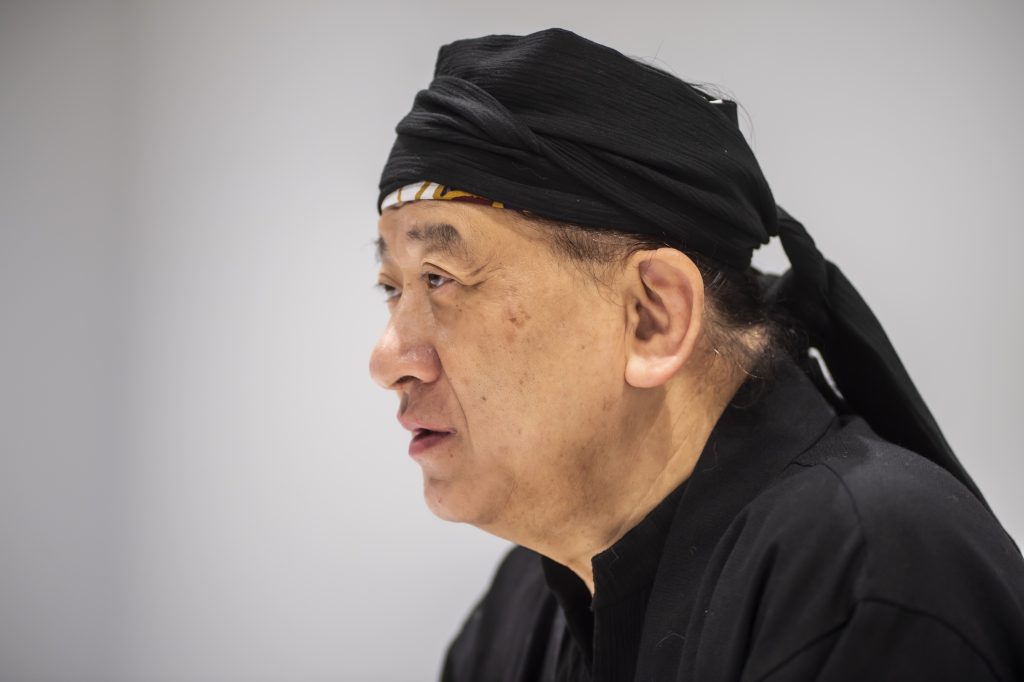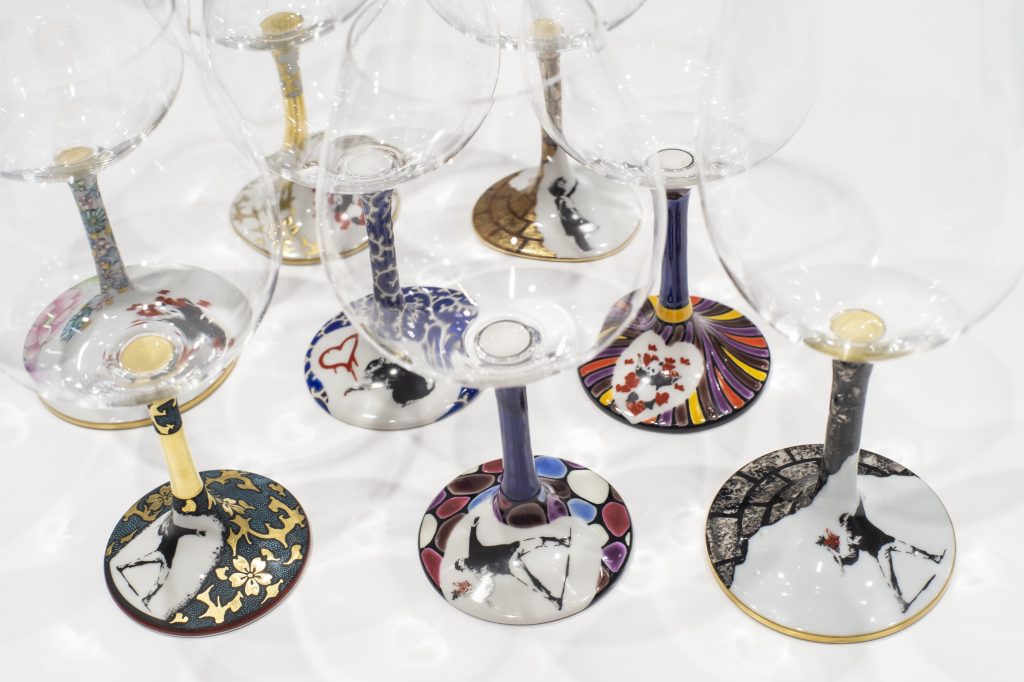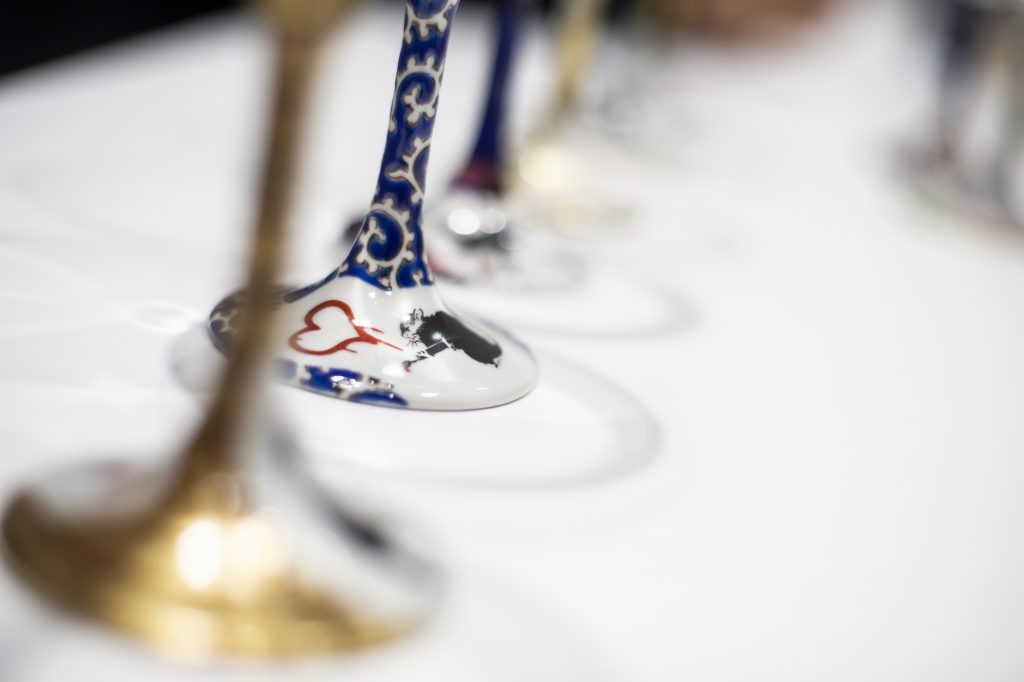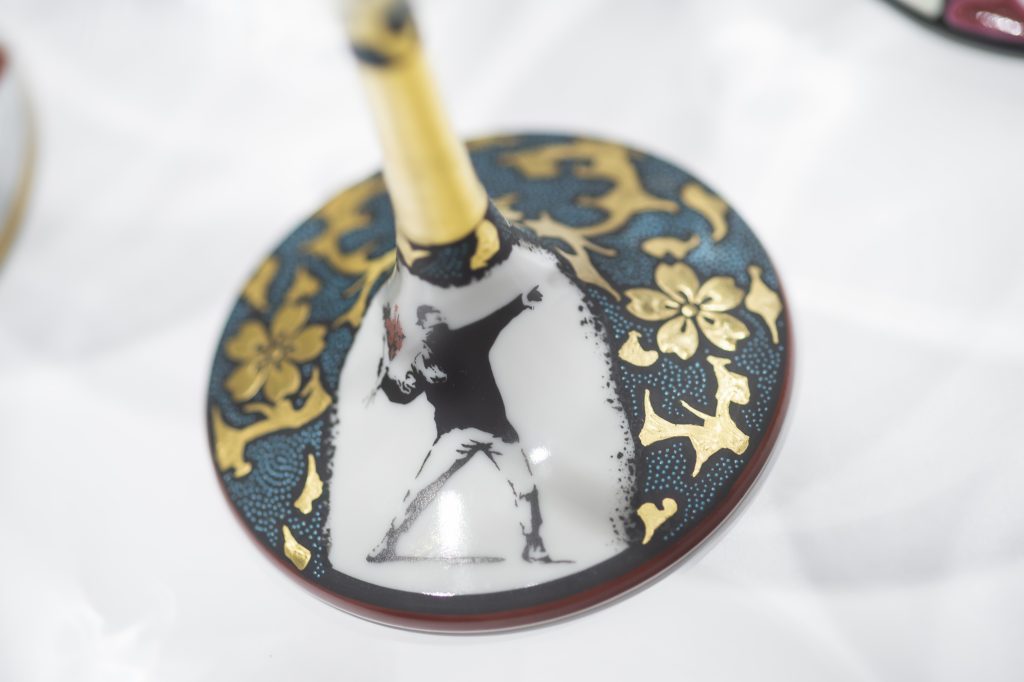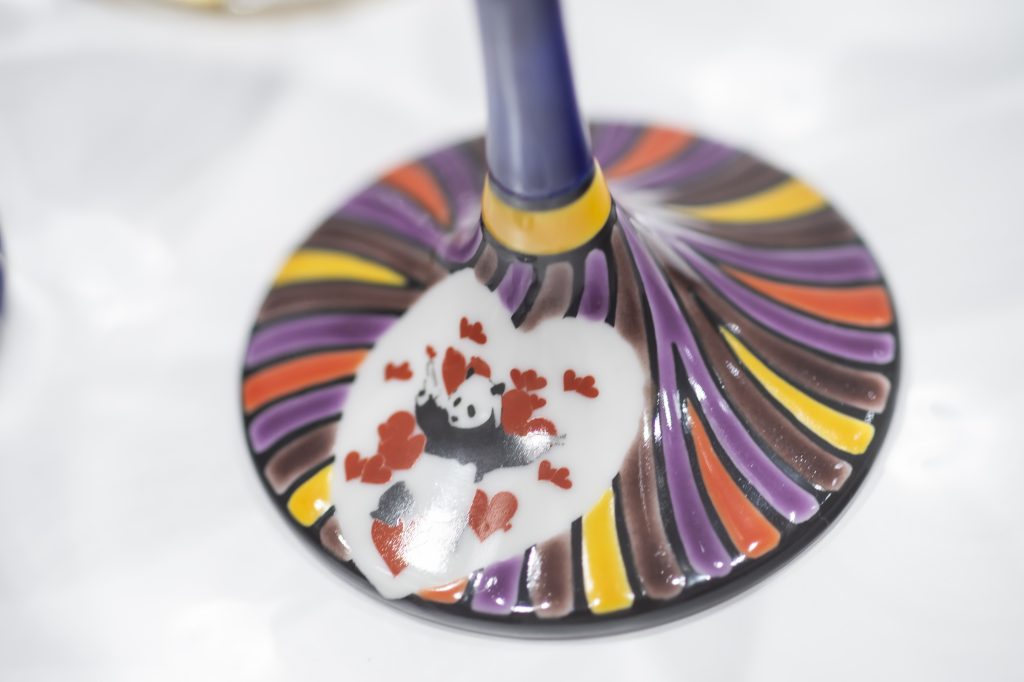Today, it is said that there is a craze for craft. Numbered tickets are often issued for solo exhibitions of popular craft artists that showcase artifacts like vessels and dishes, and there are many cases where people who wish to purchase are lined up before the opening of the exhibition. On the other hand, the production areas of crafts such as Mino and Tokoname are all in a difficult situation. Meanwhile, people of Kutani ware which is characterized by beautiful golden decorations, have realized a novel project that no one can ever think of. That is, Kutani ware wine glasses with Banksy graffiti.
Needless to say, Banksy is a masked graffiti artist who has made a great impact on the world by throwing critical questions on social problems. Kutani ware has its roots in porcelain that originated in Kutani Village (now known as Kaga City, Ishikawa Prefecture), which was under the control of the Kaga Domain during the Edo period. Why was this project born? It was realized by some freak coincidence. Motoyoshi Kaburagi, the 8th generation owner of the long-established Kutani ware pottery, Kaburagi Shoten, which has history from the Edo period, talked about how this project had happened, saying “It will be a little long story……”.
The community of wine lovers behind the project
“I have a friend in my hometown Kanazawa who loves animals and is superb at painting. That friend’s dream is to go to an African safari to see animals. He has autism, so I called upon like-minded members who are willing to support him to strive to attain his dream. However, when I consulted with the airline, I found it very difficult to make it happen. After hearing his wishes, we changed our destination to San Diego, USA. There are world-famous zoos and aquariums in San Diego. His mother and I were traveling with him together. And when I shared it on SNS, another friend of mine sent me a message saying “I was there too!” The sender was a wine-loving friend who had been connected through SNS. I like wine, and I had always been in touch with other wine lovers through SNS. She was one of them. After the chance event in San Diego, we came to have drinks together in Tokyo”
This friend, whom Kaburagi had become acquainted with through a common love of wine and formed a close friendship with, following the travel to San Diego to fulfill his friend’s dreams, was actually a person who supported a company in Japan that holds the rights to several Banksy paintings. In this way, the story came to Kaburagi, an owner of long-established pottery of Kutani ware. The combination of traditional crafts and rebellious artists was triggered by Mr. Kaburagi’s personal connection, instead of originating from the brand strategy.
The delicate painting technique of Kutani ware craftsmen: The key for obtaining consent from the agency in England
“At the museum shop, we often see the artist’s work printed on a mug. If we do the same thing with Banksy’s graffiti and porcelain Kutani ware, we cannot differentiate us from others. What’s even worse was the other enterprises can produce similar products cheaper with this kind of printing technique. Then, there is no point in doing it with Kutani ware. Therefore, I thought that what we should do was to create a decent work that was properly painted by the Kutani ware craftsmen.”
Kaburagi Shoten had been developing and selling products of Riedel wine glasses with Kutani ware stems and foot plates. This time, they produced the “BRANDALISED Glass” series as part of a graphic art project of Full Color Black, a company in the UK which develops items and brand collaborations using Banksy’s graffiti photographs. The stems and foot plates of the glasses are colored and decorated with Banksy’s “Balloon Girl,” “Love Rat,” “Flower Bomber,” and “Panda Gun,” along with Kutani ware. Mr. Kaburagi asked three up-and-coming craftspeople to paint on the products. While not spoiling the style of Banksy’s work, each product has a delicate design created using Kutani ware techniques.
They created a sample based on the idea and sent it to the UK. Later on, the glasses were successfully produced as commercial products. It happened only half a year after the idea came out.
“This successful commercialization of the wine glasses confirmed my belief that Japanese traditional crafts are world-class products.”
The main part of this series would be Banksy’s graffities. However, the depiction of bricks on the background is also created using unique Kutani techniques with gold and silver decoration, which makes these wine glasses not too far from the domain of Kutani ware. Each painting is done by hand of a craftsperson, which is the embodiment of Kaburagi Shoten’s anti-mass-production-and-consumption message. This awareness of the issues is also shared by Banksy’s activities. It’s a seemingly outlandish combination, but in fact there was a shared sense of value at the root of the Japanese traditional craft and the British street artist.
The future of traditional crafts is not up to capitalizing on the craze, but to the “transformation” for improving the value of each work
When using the works of world-famous artists for projects in Japan, most of them rely on the powerful influence of such artists. However, if it is a full-hearted traditional craft, it would not be impossible to combine it with artworks to create a synergistic effect. Instead of just printing something on white porcelain in a simple and fashionable manner, we will apply traditional techniques to decorate globally acclaimed wine glasses without spoiling the value of each work. I would say the key for the revival of traditional crafts that are in crisis nationwide is hidden in this “transformation”.
“Kaburagi, the pottery founded in the Bunsei era, will be 200 years old next year, and there is a long history of exportation of products with it. Also, because my father, who was my predecessor, passed away at a young age, I became a representative at the age of 20. I have been running a business as a president, creating ideas and doing sales while managing a team. From now on, I would like to help our partner to find something that can be combined with the graffiti of Banksy from 236 traditional crafts nationwide and to develop products in the same way as ours “
The transformation of traditional crafts with worldwide perspective started from street art. Impacts beyond the scope of planned harmony will possibly appear in various ways.
Motoyoshi Kaburagi
Motoyoshi Kaburagi is the 8th owner of Kaburagi Shoten, which opened in Kanazawa in 1822 as the first merchant of Kutani ware. In 1978, he became the representative when he was in the university. Kaburagi Shoten has been exporting products overseas since the early Meiji era, and has been actively exhibiting at world expositions overseas. In addition to showcasing their works at international exhibitions, he is actively introducing Kutani ware and Kaburagi brand products to the world. In addition, he has a profound knowledge of wine, and in 2016 he was appointed as the Minister of Economy, Trade and Industry Award Sommelier Donour (honorary sommelier).
BRANDALISED
BRANDALISED is a graffiti art project by Full Colour Black, a contemporary Art Licensing company in the UK. The project develops items and brand collaborations using graffiti photographs by masked artist Banksy. Banksy is one of the most popular street artists in the world today, based mainly in London, who draws socially satirical graffiti art using stencils in various parts of the world. His profile, including his real name, has not been disclosed. With the appearance of his works, there has been an endless stream of uncertain information about Banksy’s true identity. His work being shredded immediately after being sold at auction in 2018 made unprecedented news that went around the world.
BRANDALISED™ © MMXXI Full Colour Black Ltd.
Photography Kunihisa Kobayashi
Translation Shinichiro Sato

